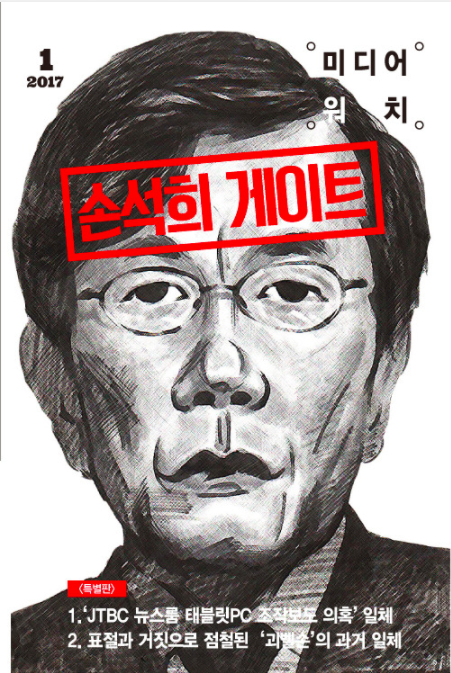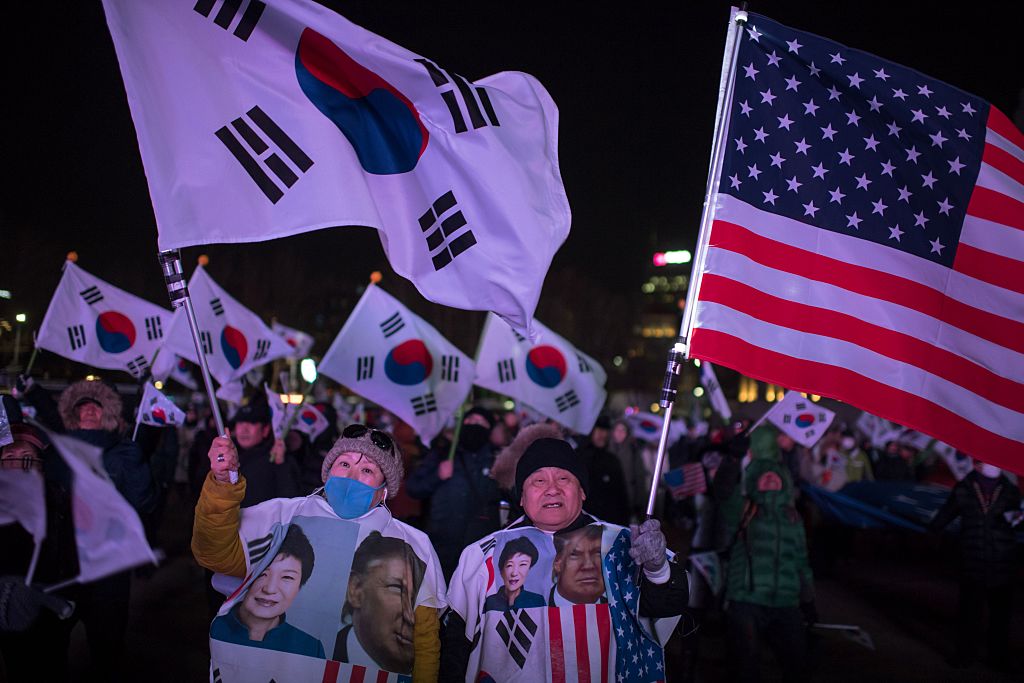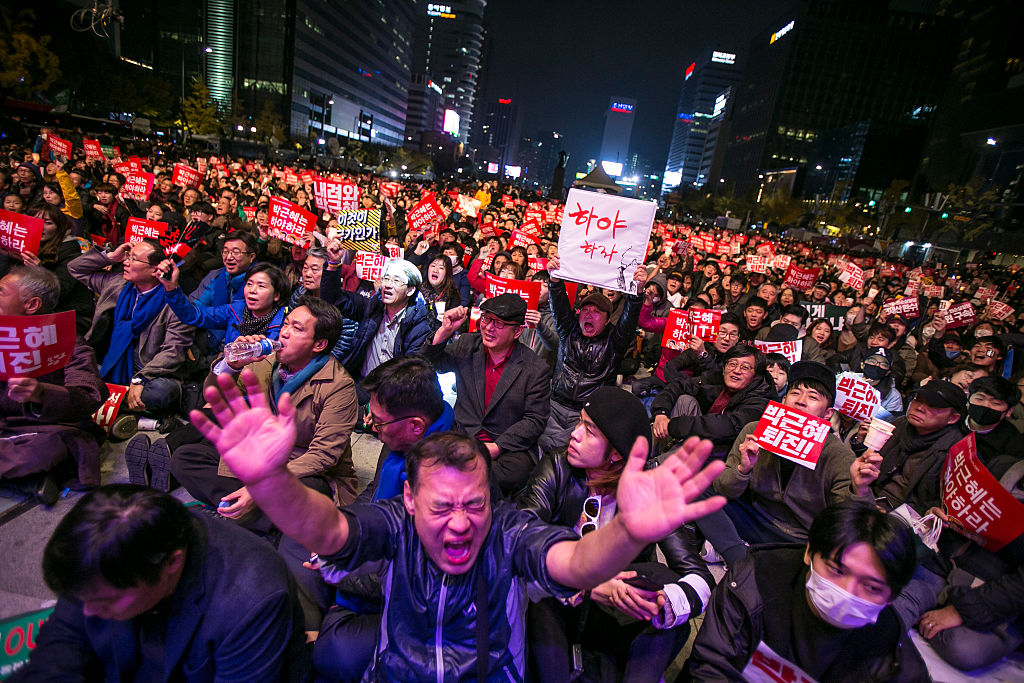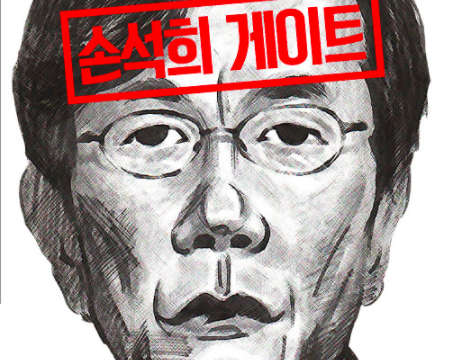Yesterday, South Korean president Park Geun-Hye was officially ousted from her office after a special Constitutional Court decision upheld her impeachment. For the majority of Koreans, it’s the end of a gruelling three-month trial and a longer national scandal. But during the biggest crisis in South Korea’s young democracy, the road to impeachment was filled with fake information spread through the popular messaging app KakaoTalk, websites and newspaper-like pamphlets in which fictional Western experts named after anime characters proved made-up conspiracies and “Donald Trump” supported Park Geun-Hye.
Before and during the trial, a flood of fake news articles dominated and muddled the public discourse about the already conspiracy-laden scandal surrounding the conservative former President Park and her Rasputin-like confidant Choi Soon-sil. Revelations over Choi’s influence over Park, from editing policy speeches to picking her daily wardrobe, and her use of said influence to funnel money from corporations to herself led to massive street demonstrations in Seoul, and in December, Park’s impeachment by the National Assembly. Through this scandal, a web of corruption was exposed and led to the indictment of head of Samsung, Lee Jae-Yong, for bribing Choi.
Amid an atmosphere of disbelief and outrage at the government, fake news articles helped rally a small but vocal base of Park supporters. From online, they grew large enough to hold counter-protests of their own. Shared on pro-Park forums, Facebook groups and KakaoTalk chatrooms, the articles discredited the anti-Park politicians and the prosecutors involved in the trial as communists and sexual harassers, respectively.

Fake news so far backed mostly Park and other conservative causes. Se-Woong Koo, the founder of the English-language online magazine Korea Expose, believes many conservatives flocked to fake news after the scandal broke and the traditional media outlets — the majority of which are conservative — abandoned their support of Park.
“After Choi Soon-sil [scandal], everybody was writing critically about the president which made traditional conservative readers feel alienated,” Koo tells Gizmodo.
Among the elderly, conservative groups in South Korea, KakaoTalk reigns king of the smartphone. KakaoTalk is ubiquitous in South Korea and most people over 60 years of age — 76 per cent of whom owns a smartphone, according a Gallup study — learned to use the messaging app with relative ease.
A 29-year-old moderator of a popular website called Daily Padak — which, after public pressure, now highlights on their homepage that they are a fake news site where people can make up stories “to hook [their] friends in” — told the centrist paper Hankook Ilbo that 60 per cent of Daily Padak’s traffic comes from Kakaotalk, double the traffic from Facebook and Twitter combined.
Within these pro-Park KakaoTalk chatrooms, the users are spammed with doctored headlines, photos and videos that look vaguely legitimate. Subscribers in these chatrooms receive several hundred, sometimes over a thousand, messages on KakaoTalk every day, according to Koo. Anti-Park conservative politician Ha Tae-Kyung said he receives 500 messages a day and “half are fake news”.
Despite the deluge of fake news, the overarching narrative is quite simple. Every fake news story seems to focus on how the entire scandal and its subsequent protests are a leftist conspiracy to bring down Park’s conservative regime. Many of the fake news stories fell under three common forms:
- A fictional Western media outlet, political expert or politician speaking out against Park’s impeachment
- Made-up data proving how the pro-Park faction is growing, or surpassed, the anti-Park faction
- So-called evidence tying the Choi Soon-sil scandal and anti-Park protests to North Korea
The first category is where fake news creators arguably gets the most creative. One article says a British professor named Artoria Pendragon discovered shadow organisations coordinated the impeachment protests; Pendragon, however, is a character from the Japanese anime Fate/stay night. Another claimed a Stanford professor named Simon Littner (surname also borrowed from a character in another anime called Gurren Lagann) wrote that the impeachment was part of a shadowy “power game” played by China and North Korea.

Pro-government activists take part in a rally denouncing the impeachment of Park in Seoul on January 14, 2017. Photo: ED JONES/AFP/Getty Images.
One of the most popular people “quoted” in fake news stories was not a fictional expert but the real President of the United States. Donald Trump supposedly spoke against Park’s impeachment on December 19, telling CNN that he was concerned that Park’s impeachment will affect the global economy in broken English. “I am very sorry that Park Geun-hye impeached. Korea is America’s most influential partner,” said “Trump” in a now-deleted fake news article, as reported by the left-wing TV network JTBC in one of their many special news segments on fake news. This fake news article was shared at least 1500 times on Facebook and Twitter, according to JTBC.
Made-up poll numbers also proved to be a popular fake news format as well. One March 5 poll shared in Park’s popular fan club forum called Park-Sa-Mo found only 31 per cent supported Park’s impeachment while 47 per cent opposed. It was conducted by a non-existent group called NK Financial Research. In reality, a Gallup poll from March 3 found that 77 per cent supported impeachment and 18 per cent opposed it. Another company called Realmeter polled near-identical figures (77 per cent support impeachment, 20 per cent against) in its final pre-verdict poll on Friday.
But the most popular and nefarious form of fake news has been the North Korea connection. Tapping into a longtime fear of communism stemming from the Korean War, fake news articles continually sought to connect dots between efforts to impeach Park and North Korea. Rumours like North Korean agents flooding Seoul during the protests or fake material like a letter written by the opposition party leader to Kim Jong-Il labelled anti-Park protesters and politicians as pro-North Korean communists.
As a result in one pro-Park protest, protesters carried a large American flag and hung a poster with images of Park and Trump and the slogan “Make Korea & America Great Again”.
The red-baiting has made its way into President Park’s most inner circles. Park’s attorney Seo Seok-gu argued in the Constitutional Court during a hearing that the anti-Park protests were coordinated by North Korea, using a fake North Korean state newspaper which celebrates the protests as evidence for the connection. When confronted during a live television interview, Seo said he “already expressed his regrets” for the allegation.

Tens of thousands of South Koreans took part in a rally to demand President Park Geun-Hye to step down on 12 November 2016 in Seoul, South Korea. Photo: Jean Chung/Getty Images.
While fake news may not have deterred the trial or the prosecution, many politicians and journalists are concerned how fake news will impact the special election scheduled to occur in 60 days. Concerned with the role fake news and conspiracy websites played in America in promoting misinformation before the election, the prestigious Seoul National University and Naver, South Korea’s most popular search engine site, plans to roll out a fact-check feature for the latter later this month.
In the United States, private companies like Facebook and Google are being challenged to clean up their fake news problem. In South Korea, the government vowed to help crack down on fake news. Last month, interim President Hwang Kyo-ahn pledged the federal police and the Ministry of Science will monitor and stop fake news acting as legitimate news outlets.
But Koo notes the government will not investigate news shared on messaging apps like KakaoTalk which renders the crackdown toothless. “I find it laughable that the police are seeking to shut down the country’s thriving rumour mill,” Koo writes in his fake news feature on Korea Expose.
Last November, the opposition Democratic Party also created an online “rumour report center” to compile and contain fake news articles surrounding the scandal, the impeachment trial, and most importantly, about their leader and current presidential frontrunner Moon Jae-In.
Moon Jae-In needs not to look far on how fake news can ruin a politician’s presidential ambitions. Before Moon became the frontrunner, former United Nations Secretary-General Ban Ki-moon was seen as a shoo-in as Park’s conservative successor. But Ban dropped out, claiming fake news gave undue stress to him and his family. “My genuine patriotism and passion were damaged by rumours and fake news,” Ban said on February 1.
It is true that fake news have been written about Ban, like a viral fake news post about his UN successor Antonio Guterres saying that Ban running for president was a violation of UN rules. But what is also true is that his younger brother and nephew were indicted in the United States for bribery — a crime so matter-of-fact in Korean politics that it’s hard not to believe.
